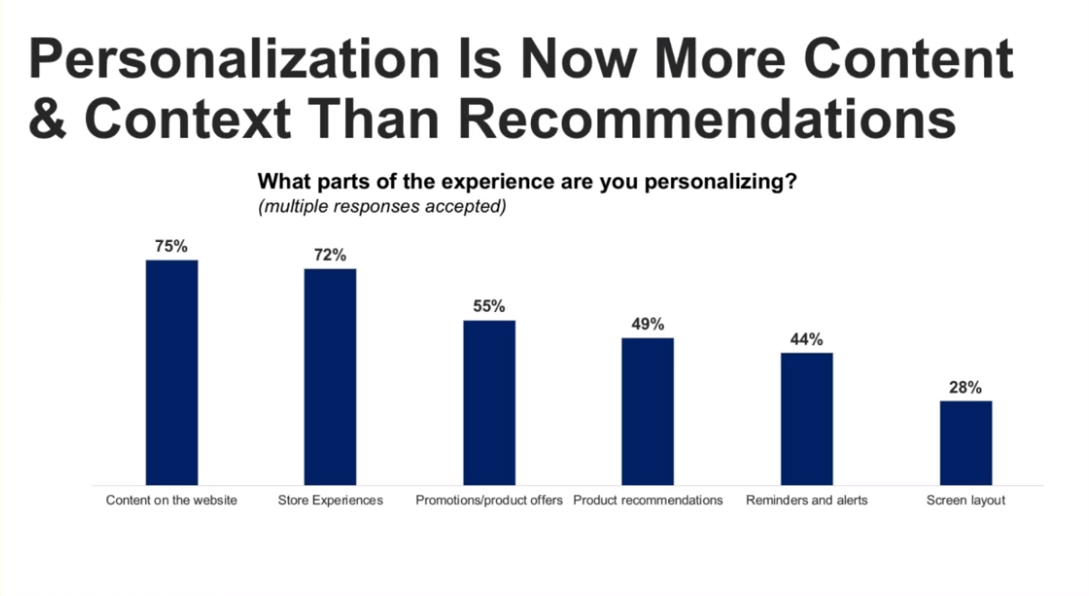“I am a person before I am anything else. I never say I am a writer. I never say I am an artist…I am a person who does those things.” —Edward Gorey
Being greeted with your name and recommendations for products and services is common for return website visits, but personalization is evolving rapidly. And rightly so: “More than three-quarters of consumers see personally relevant content as the key to engaging more deeply with a brand and considering the products and services they provide,” concluded a report sponsored by Marketing Insider Group and Onespot.
Developing superior consumer website experiences involves engaging users more directly. An example of enhancing personalization is already happening in retail, as shown in 2018 survey results from Forrester.
“Individualization” has emerged as the term describing the effort to develop more uniquely engaging website experiences specific for each person. Individualization differs from segmentation, where personas are developed to represent different pools of users in order to deliver targeted content to defined groups of customers. Segmentation is valuable for identifying an individual as this or that type of consumer, but it stops short of recognizing, as Edward Gorey declared, “I am a person before I am anything else.”
Authentic, tailored content adds value to a consumer shopper’s journey, as noted in an eMarketer Customer Experience Roundup, reflecting that individualization is value-oriented. Expanding on personalization with the goal of encouraging users to engage more deeply with your brand, products, and services provides website owners an excellent opportunity to recast their content strategy. If personalization is indeed now more about content and context, content strategy should span from data collection through content delivery to ensure relevant content is present precisely at points of need and interest in the user journey. Your content management system (CMS) will play a crucial role in identifying the right content for the user.
Know Thy User
Of course, data collection is vital for identifying user characteristics, but it is increasingly being enriched by user participation. Engage users to develop their personal profiles. Among other benefits to brand identification, involving the person helps mitigate the creepiness factor concerning what you know about them only through data collection.
Continuing advances in the use of artificial intelligence, conversational interfaces, and chatbots present opportunities for engaging and individualizing your customers. As data collection spurs further development, analytics can simultaneously help you measure and evaluate content effectiveness and performance. Personalization leads to a greater desire to know how content is actually working.
Prepare to Deliver
Individualization brings into strategic focus the context in which to introduce relevant content, and your content management system is crucial for delivering the right content at the right time. Consider your legacy content—product and services information, marketing copy and press releases, blog posts, articles, white papers, and other content. Personalization offers the chance for multiple uses of that content.
Drawing users’ attention to pertinent legacy content at the right time, in context, enhances the user experience. Take all those blog posts, for example. If posts are intelligently tagged, relevant blog content can be made accessible and available when the user is showing interest in a topic featured in a post. Your CMS should drive the goal of creating a piece of content once, but having it available from multiple access points, places in the user journey where context drives content.
As personalization evolves, the stakes are high and beyond what you might normally use as benchmarks for content and user experience. Customer experience expands beyond your immediate competitors to best web practices. “No brand is safe from the awesome power of a superior customer experience,” observed Mike Sands in Forbes: “Consumers — particularly young ones — have shown that they will rapidly shift loyalties to brands delivering an overall experience that is more personalized and easier to use, both online and offline.”


